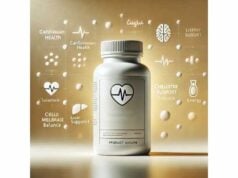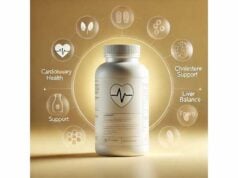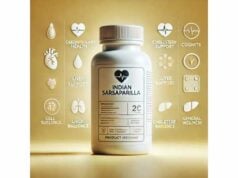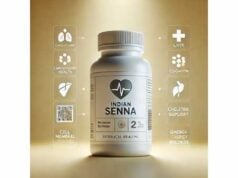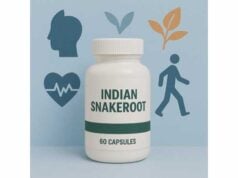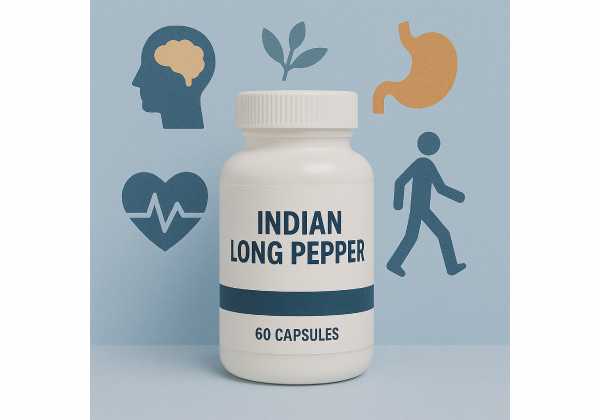
Indian long pepper (Piper longum, often called pippali) is both a spice and a traditional remedy with a distinct sweet-heat that lingers longer than black pepper. Beyond the kitchen, it appears in classical Ayurveda—on its own and in blends like Trikatu—primarily for digestion, respiratory comfort, and sluggish metabolism. Modern interest centers on its amide alkaloids, especially piperine and piperlongumine, which may influence how the body absorbs other compounds, modulate enzymes and transporters involved in drug metabolism, and contribute antioxidant and anti-inflammatory effects. In practical terms, people use Indian long pepper for heavy-meal sluggishness, to pair with hard-to-absorb botanicals (e.g., curcuminoids), and as part of short courses for seasonal congestion. This guide translates tradition and emerging science into clear steps—how it may help, where evidence is strongest, how to choose a form and dose, what to avoid, and how to use it responsibly.
Key Insights
- Standardized piperine (from Piper species) can increase the bioavailability of certain compounds; culinary pippali supports digestion and warmth after meals.
- Typical adult ranges: 300–1,000 mg/day whole-fruit powder for culinary-digestive use; 5–20 mg/day piperine when used as a bioavailability adjunct.
- Safety caveat: piperine may alter drug metabolism (CYP3A4, P-glycoprotein); discuss with a clinician if you take prescription medicines.
- Avoid in pregnancy and breastfeeding, in children, with active ulcers, gallstones, significant liver disease, or when using narrow-therapeutic-index drugs without medical guidance.
Table of Contents
- What is Indian long pepper?
- Benefits: what it may help
- How to use: forms and prep
- Dosage: practical ranges and timing
- Safety, side effects, interactions
- Mistakes, troubleshooting, and use cases
- Evidence: what the research says
What is Indian long pepper?
Identity and flavor profile.
Indian long pepper (Piper longum L.) is a slender, catkin-shaped pepper fruit that dries to a brown, knobbly spike. The flavor is warmer and more complex than black pepper—initially sweet, then progressively hot, with a gentle numbing finish. In regional cuisines across South Asia and parts of Southeast Asia, it seasons meats, pickles, lentils, and tonics. In Ayurveda, it’s referred to as pippali and classed as “ushna” (warming) and “deepana-pachana” (kindling appetite and aiding digestion).
Active constituents at a glance.
Long pepper contains multiple bioactive amide alkaloids—piperine, piperlongumine, piperlonguminine, and related analogs—plus essential oils and minor polyphenols. Among these, piperine is the best studied. It can influence intestinal transporters and drug-metabolizing enzymes, which partly explains why many modern “bioavailability-enhanced” formulas add small amounts of piperine.
How the chemistry relates to effects.
- Digestive heat and motility. The tingling heat stimulates salivation and gastric secretions, which many people experience as easier digestion of richer meals.
- Bioavailability adjunct. Piperine can reduce the intestinal and hepatic “first-pass” elimination of certain compounds and modulate efflux pumps, occasionally yielding higher systemic exposure when co-administered.
- Respiratory comfort. Traditional use pairs pippali with ginger and black pepper (Trikatu) for thick congestion and sluggishness, often as short courses with honey or ghee; the warming profile encourages thinning and movement of secretions.
- Metabolic tone. Classical texts position pippali for “ama” (undigested residue) and low digestive fire; contemporary wellness seekers sometimes use it in gentle metabolic stacks, though expectations should remain modest without broader lifestyle change.
Whole fruit vs. standardized extracts.
- Whole-fruit powder preserves the culinary-tonic spectrum with modest alkaloid levels.
- Extracts can concentrate piperine or broader alkaloids for specific goals (e.g., pairing 5–20 mg piperine with curcuminoids). Labels should disclose standardization (percent piperine) and batch testing.
Quality signals to look for.
- Correct botanical name Piper longum and plant part (fruit).
- Standardization (for extracts): percent piperine or total amide alkaloids.
- Contaminant testing (heavy metals, pesticides, microbiology) and origin.
- For culinary spikes, aroma should be resinous-peppery with a subtle sweetness; stale material smells flat and dusty.
Benefits: what it may help
1) Digestive comfort after heavy meals
Long pepper’s heat and bitterness can increase salivation and a sense of gastric readiness. In practice, people use a pinch to ¼ teaspoon sprinkled on savory dishes, or 300–500 mg of whole-fruit capsules with meals. For many, this reduces post-meal fullness and supports more regular bowel habits over days to weeks when combined with fiber and steady mealtimes. Expect subtle effects—think smoother post-prandial feel rather than a dramatic change.
2) Respiratory support in seasonal sluggishness
Classic formulas like Trikatu (long pepper + black pepper + ginger) are taken as short courses for thick mucus and a “heavy head” feeling. The culinary-warming nature promotes nasal clearance and a subjective sense of airflow, particularly when paired with warm fluids, rest, and humidified air. Contemporary users often choose evening doses to minimize daytime throat tickle. As with any respiratory concern, red-flag symptoms (fever, chest pain, breathlessness) warrant medical care.
3) Bioavailability “boost” for select compounds
Piperine can alter the fate of some co-ingested molecules—raising measured blood levels in controlled settings. The most cited example is curcumin, where 20 mg piperine with 2,000 mg curcumin in healthy adults produced a marked increase in measured curcumin exposure compared with curcumin alone. In the real world, people reach for low-dose piperine (often 5–10 mg) within turmeric blends, fat-based meals, or both. This strategy is compound-specific; it does not universally improve absorption and may shift drug handling (see Safety).
4) Metabolic and weight-management adjunct (modest)
Traditional framing suggests pippali “stokes the fire,” and small modern studies using poly-herbal combinations (e.g., Trikatu with lifestyle changes) report improvements in weight-related measures. Is pippali solely responsible? Unlikely. However, as a habit cue—adding a pinch to protein-rich, fiber-forward meals—long pepper can help anchor a broader metabolic routine around home cooking, portion awareness, and satiety.
5) Cognitive and mood tone via comfort and ritual
Not a direct nootropic, but people often report a clearer, “lighter” feeling when digestive heaviness and congestion recede. Warm, spiced teas (ginger-pippali-lemon-honey) can serve as wind-down rituals—simple, pleasant practices that support consistency with sleep and hydration.
What it will not do
- It is not a stand-alone therapy for chronic disease.
- It will not replace compression stockings, inhalers, statins, or antibiotics when those are indicated.
- It is not a universal bioavailability hack; effects vary widely by compound and person.
How to use: forms and prep
Culinary spice (whole spikes or coarse powder)
- Use: Crush spikes in a mortar or mill; add near the end of cooking to preserve aroma.
- Pairings: Lentils, stews, roasted vegetables, braises, and milk-based tonics (with ginger, cardamom).
- Everyday approach: A pinch to ⅛ tsp per serving adds warmth without overwhelming other flavors.
Whole-fruit capsules or powder
- Digestive support: 300–1,000 mg/day, with meals (split doses).
- Seasonal respiratory support: 300–600 mg, 1–2× daily for 3–7 days, often blended with ginger and black pepper.
- Tip: Start on the low end; long pepper can “creep up” in heat. Take with food and a glass of warm water.
Standardized piperine extracts
- Bioavailability adjunct: 5–20 mg/day piperine, usually 1 dose taken alongside the target compound (e.g., curcuminoids).
- Digestive-tonic alternative: If you prefer the whole-food experience, use the spice form instead of isolated piperine.
- Quality: Look for assayed piperine content and third-party testing.
Traditional preparations (examples, food-first)
- Simple pippali tea (soothing):
1 cup hot water, ½ tsp crushed long pepper, a slice of fresh ginger, optional lemon and honey. Steep 8–10 minutes covered. Sip warm, 1–2×/day for 3–5 days. - Digestive ghee (meal companion):
Melt 2 tbsp ghee on low heat; stir in ½ tsp each crushed long pepper and coriander seed; cool and store. Add ½ tsp over warm grains or soups to deliver flavor and dose together.
Stacking without overdoing it
- With turmeric: piperine-containing blends are common; keep piperine ≤20 mg/day unless supervised.
- With ginger: complementary for post-meal comfort and travel bloat.
- With fiber: pair warming spices with 25–38 g/day total dietary fiber to target regularity.
- Avoid combining with multiple stimulant spices at high doses if you have reflux or gastritis.
Buying and storing
- Choose aromatic spikes from recent harvests; grind small amounts weekly.
- Store in an airtight jar away from light and heat; use within 6–9 months for best flavor.
- For capsules/extracts, prefer brands providing COAs, batch numbers, and contaminant testing.
Dosage: practical ranges and timing
Adults (general guidance)
- Culinary/tonic use (whole fruit): 300–1,000 mg/day (about ⅛–¼ tsp powder), with meals; titrate by 100–200 mg every few days as needed.
- Short-course respiratory support: 300–600 mg, 1–2×/day for 3–7 days.
- As a bioavailability adjunct (piperine): 5–20 mg/day, co-administered with the target compound; stay at the lowest effective dose.
Older adults
- Start at 100–300 mg/day whole fruit or 5 mg piperine. Increase slowly while monitoring for reflux, heartburn, or dizziness, and ensure adequate hydration.
Not for children, pregnancy, or breastfeeding
- Skip supplemental forms in these groups due to warming potency and potential drug-interaction concerns. Culinary use in tiny amounts may be culturally customary, but supplements should be avoided unless a qualified clinician advises otherwise.
Timing
- With meals is best for digestion and tolerance.
- For bioavailability support, dose at the same time as the companion compound.
- For respiratory goals, many prefer evening to minimize daytime throat tickle.
Cycling and duration
- Culinary use can be ongoing if well tolerated.
- Supplemental courses: reassess every 4–8 weeks; for respiratory short courses, limit to ≤7 days unless your clinician suggests otherwise.
- If you require continued “boosts” to feel well, zoom out and address sleep, hydration, fiber intake, movement, reflux triggers, and medications that affect digestion.
Dose-response expectations
- Digestive comfort: improvements typically show within 3–7 days of consistent, low-dose use with meals.
- Bioavailability pairing: effects depend on the other compound; do not assume a benefit across the board.
- If nothing changes after 2–3 weeks at conservative doses (and your diet is in order), consider discontinuing or switching strategies.
Safety, side effects, interactions
Common, usually mild
- Gastrointestinal: warmth, heartburn, stomach upset, loose stools at higher culinary doses; these often resolve by lowering the dose or taking with food.
- Throat tickle or cough with powders—reduce dose or switch to capsules.
Less common but important
- Skin flushing or warmth after concentrated extracts.
- Headache or dizziness in sensitive users, particularly when dehydrated or combining multiple warming spices.
Drug-metabolism considerations (key point)
- Piperine can inhibit CYP3A4 (a major drug-metabolizing enzyme) and P-glycoprotein (a drug-efflux transporter). Practically, this may increase blood levels of certain orally administered drugs or botanicals.
- Who should be cautious or avoid without supervision:
- People taking narrow-therapeutic-index medications (e.g., cyclosporine, tacrolimus, certain antiarrhythmics, some antiepileptics).
- Those on CYP3A4-sensitive drugs (some statins, calcium-channel blockers, benzodiazepines, certain HIV therapies).
- Individuals using anticoagulants/antiplatelets or sedatives, given potential additive effects or altered handling.
- If you use prescription medicines, speak with your clinician or pharmacist before adding piperine-standardized products. Culinary pinches are less concerning but still worth mentioning.
Who should not use supplemental long pepper
- Pregnant or breastfeeding individuals (avoidance recommended).
- Children and adolescents (supplement forms).
- Anyone with active peptic ulcers, severe reflux, gallstones, or significant liver disease.
- People with a history of laxative misuse or spice-triggered reflux.
Stop and seek care if
- You develop severe abdominal pain, persistent vomiting, black stools, chest pain, fainting, yellowing of eyes/skin, dark urine, or any allergic reaction (wheezing, hives, swelling).
Practical safety tips
- Start low and increase slowly; more heat is not more benefit.
- One change at a time—introduce pippali or piperine separately from other new supplements.
- Hydrate and pair with fiber-rich meals to avoid GI irritation.
- Disclose use to your clinician, especially before procedures or when medications change.
Mistakes, troubleshooting, and use cases
Frequent mistakes
- Treating piperine like a universal booster. Bioavailability effects are compound-specific; benefits with one molecule (e.g., curcumin) don’t guarantee benefits with another, and interactions with medicines are possible.
- Jumping to high doses. Overshooting leads to heartburn and loose stools without proportional gain.
- Ignoring the base diet. Spices amplify good habits; they don’t replace protein, fiber, and hydration.
- Layering multiple piperine products (a turmeric blend, plus a “metabolism” capsule, plus a pippali capsule) and accidentally exceeding 20 mg/day piperine.
Troubleshooting
- Heartburn after meals: cut the dose by 50–75%, move dosing mid-meal, and avoid late-night spicy foods.
- No digestive change after 2 weeks: evaluate chewing speed, fiber intake (target 25–38 g/day), reflux triggers (late coffee, alcohol), and meal timing. Consider switching to ginger-forward blends if you’re heat-sensitive.
- Medication concerns: if you must stay on a CYP3A4-sensitive drug, avoid piperine-standardized products; stick to culinary pinches or skip pippali entirely.
- Powder causes throat tickle: use capsules or infuse in ghee and add to food.
Scenario examples
- Heavy-dinner traveler: ⅛ tsp long pepper on dinner entrées; warm ginger-pippali tea after the meal; morning walk and water bottle; reassess after 3 travel days.
- Curcumin user with consistency issues: switch to a single capsule formula providing 500–1,000 mg curcuminoids + 5–10 mg piperine with lunch; keep a simple pill minder; evaluate joint comfort and training recovery after 4–6 weeks.
- Seasonal congestion (no red flags): 300 mg pippali with ginger twice daily for 5 days, steam inhalation in the evening, and early bedtime. Stop if symptoms escalate or persist beyond a week.
Evidence: what the research says
Bioavailability and drug-handling
Human and mechanistic research shows that piperine can meaningfully alter absorption and metabolism of certain compounds. In a controlled human crossover study, curcumin 2,000 mg + piperine 20 mg produced a much higher measured curcumin exposure than curcumin alone. Laboratory work indicates piperine can inhibit CYP3A4 and P-glycoprotein, proteins central to first-pass elimination and drug efflux. Separate pharmacology reviews continue to detail these interactions, emphasizing both the potential upside (for targeted nutraceuticals) and the interaction risk (for medications).
Indian long pepper beyond piperine
Piper longum also supplies piperlongumine and related amides investigated for antioxidant and anti-inflammatory activity in preclinical models. Comprehensive botanical reviews summarize ethnobotanical use (digestion, respiratory support) and emerging molecular targets. While laboratory signals are intriguing, human randomized trials isolating P. longum remain limited; many modern studies examine poly-herbal formulas (e.g., Trikatu), making it hard to ascribe effects solely to pippali.
Clinical signals and their limits
- Ayurvedic formulations (e.g., Trikatu): contemporary randomized studies suggest improvements in measures like body mass or lipids when combined with lifestyle changes. These data are encouraging but heterogeneous, often with small sample sizes and multiple co-interventions.
- Safety and interactions: human and in vitro work around CYP3A4 and P-glycoprotein informs real-world caution with medications. Reviews also note variability across commercial products, reinforcing the need for quality control and conservative dosing.
Bottom line
- The strongest evidence around Indian long pepper in modern contexts centers on piperine-mediated changes in bioavailability and enzyme/transport modulation.
- Traditional digestive and respiratory uses have face validity and culinary plausibility, with modern poly-herbal studies providing supportive—but not definitive—signals.
- Smart practice means low doses, short courses, and attention to drug interactions, especially when using piperine-standardized products.
References
- Influence of piperine on the pharmacokinetics of curcumin in animals and human volunteers 1998 (RCT/Crossover Pharmacokinetic Study)
- Piperine, a major constituent of black pepper, inhibits human P-glycoprotein and CYP3A4 2002 (Mechanistic Study)
- Molecular and pharmacological aspects of piperine as a potential bioenhancer and therapeutic agent 2022 (Review)
- Piper longum L.: A comprehensive review on traditional uses, phytochemistry, and pharmacology 2022 (Review)
- Investigating Bioavailability of Curcumin and Piperine: A Head-to-Head Comparison of Four Individual Formulations Using In Vitro Models 2024 (In Vitro Study)
Disclaimer
This guide is educational and is not a substitute for personalized medical advice, diagnosis, or treatment. Indian long pepper and piperine can interact with medicines by altering their absorption and metabolism. Do not use supplemental forms during pregnancy or breastfeeding, in children, or if you have ulcers, gallstones, significant liver disease, or take narrow-therapeutic-index drugs unless a qualified clinician advises you. Stop use and seek care if you develop severe abdominal pain, black stools, chest pain, fainting, or signs of liver problems (jaundice, dark urine, persistent nausea).
If you found this article useful, please consider sharing it on Facebook, X (formerly Twitter), or your preferred platform, and follow us for future evidence-informed content. Your support helps us continue producing practical, people-first health guides.

